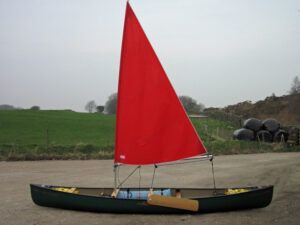Leeboards are generally used in sailing canoes to prevent leeway whilst sailing upwind. Most dinghies would use a dagger board or centre board, but the sailing canoe is narrow by comparison and the centreboard trunk or dagger box would take up a lot of room, so it is more advantageous to hang the board on the outside of the hull. Also with modern plastic open canoes that are also used for paddling, the idea of cutting a long slot in the bottom of the canoe to accomodate a centreboard trunk would not make sense. Daggerboards also dont kick up if you hit an underwater obstacle, and on a cruising boat visiting new cruising grounds you can never be sure where the obstacles are.
Leeboard Thwart
The Leeboard is usually mounted on its own thwart that goes across the top of the gunwales. This can either bolt directly through the carrying yoke or bolt through the inner gunwales depending on the position that you need. The leeboard pivots on its own large bolt that is mounted at right angles to the thwart. In this picture there is a large metal angle iron which is fastened to the thwart on one face, with the leeboard bolt coming out of the other face. The forces on this angle iron are large so this needs to be substantial to prevent it from bending. The one in the picture is 4 inches by 4 inches and 3/8 inch thick. The board is held in place with a large locking handle, so the board can be raised or lowered and locked in place.
This picture shows the leeboard bracket without the Leeboard.This one is mounted on a short thwart that is bolted with wing nuts to a fixed centre thwart. It shows how the leeboard thwart can easily and quickly be removed to free up the side of the canoe for paddling.
Even on purpose built sailing canoes it still makes sense to use a Leeboard. Here the leeboard thwart is incorporated with the beam that holds up a fore deck. Again you can see the locking handle that is used to hold the board in position on the water, or in this case on its trolley on the beach. This board is 4ft 6inches long with its handle and 8inches wide. The board needs to be this long so that if its on the upwind side and the canoe is heeling away from it, there is still sufficient board in the water to still work. Some people have used two smaller boards, one on each side, so that the canoe heeling always leaves one fully submerged. But in the UK we have favoured the long single board. This leaves one side of the canoe clear for paddling or for coming against a jetty.
To make the board more efficient for sailing upwind the cross section is foil shaped. This board is 7/8 inch thick but the leading edge on the left is thinned and rounded to about 1/4 inch wide. The trailing edge on the right is gradually tapered to about 1/8 inch thick. The widest part is about 1/3rd of the way from the leading edge. This shape will work much better than a flat board and will give a lot of leeway prevention whilst reducing the drag.
Where to place your leeboard
It is important that the leeboard and rig are placed so the centre of effort of the sail is close to the leeboard.This gives you more control of the sail force and allows you to easily sail upwind. In the picture below the leeboard is placed on the carrying yoke with a kneeling thwart 2ft behind. The mast is positioned so that the sails centre of effort is close to the leeboard. The sailor sits near the centre of the canoe so it has level trim and the leeboard and mast are easy to reach for adjusting or reefing. If you take a passenger they can sit on the floor between the leeboard and mast thwart. This keeps the level trim and everyone is sitting in the widest part of the canoe, where you can move your weight to the side to hold up the sail when going upwind. If you dont have a carrying yoke you could move the leeboard thwart and mast thwart a little further forward to give youself a little more room in the centre of the canoe, but do keep it easily reachable. In the picture you can see that the tandem seating positions are still useable for tandem paddling, but you would solo paddle from the kneeling thwart.

Leeboard on an Old Town Penobscot sailing upwind